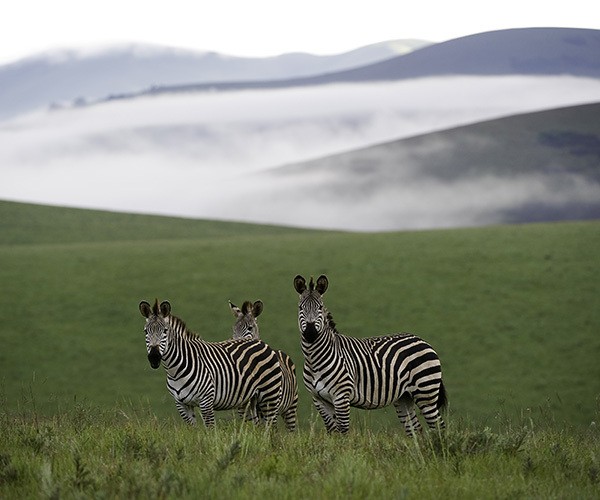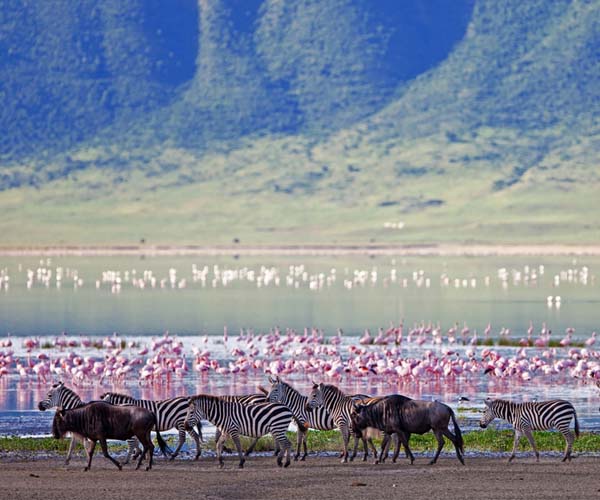Ngorongoro Conservation Area
Where the magic happens at nature's pace
Find Your ExperienceThe Ngorongoro Crater - with its lush green plains, woodland trees and wildflowers - is one of the most popular travel destinations in Tanzania. A stunningly beautiful place, it's often referred to as the ‘Garden of Eden’. Ngorongoro Conservation Area has been the site of numerous archaeological discoveries over the years, and it's now one of the best places for safari in East Africa.
The Ngorongoro Conservation Area (809,440 ha) offers a great variety of landscapes. From vast expanses of highland plains to savannas and forests, but is mainly known for the Ngorongoro Crater.
Once an impressive vulcano, now an ancient natural wonder. The Ngorongoro Crater is the largest un-flooded and unbroken caldera in the world. Its size is about 20kms across and its walls reach a dept. of 600 meters.
This three-million-year-old caldera now shelters one of the most beautiful wildlife havens on earth. Here you may find the densest population of wildlife on earth.
Due to its unique features, the Ngorongoro Crater is officially recognized as a UNESCO world heritage site and one of the ‘7 official wonders of Africa’.
Access to the crater for safaris is limited to between 7am and 4pm. For photographers, consider getting down to the crater at sunrise, beating the crowds, so no other vehicles obstruct your shots.
Safaris In Ngorongoro are game drives. The small area of the park combined with its popularity means that it can get busy during peak season.
The Southern Highlands, unlike the rest of the crater, are less frequented by travellers. This is in part because there is less wildlife in the area as the Maasai lead their cattle through here. If you've got a bit of extra time, it's worth passing through here to meet some of the local Maasai people.
You can also take a walking safari with an experienced ranger up to the rim of the Western Great Rift Valley. There are few predators in this region, so it allows you to see animals like ungulates and antelope up close.
The best time to visit the Ngorongoro Conservation area is from June to February if you are coming for the Great Migration. Wildlife lives at the crater year-round, which means you can visit at any time of year and still get great game viewing.
There are two options to get to the crater. The first is to drive from Arusha to the crater, which takes about 4 hours. A common setup is to get picked up from Kilimanjaro Airport.
Volcanic craters form stunning backdrops to some of the most fertile and richest grazing grounds in Africa. The most famous such crater is without question Ngorongoro, the world's largest intact volcanic caldera and home to the highest density of big game in Africa.
Add this Ngorongoro Conservation Area experience to Tanzania Safari Tours ideas or contact us.
to start planning your own tailor-made safari to Tanzania. Pukka Adventures provide rich, diverse, fulfilling Safari and Cultural experiences on Ngorongoro Conservation Area! Your Tanzania Safari awaits! Book Now!


100% CHANCE

95% CHANCE

100% CHANCE

100% CHANCE

100% CHANCE

100% CHANCE

100% CHANCE

100% CHANCE












January usually marks the start of the short dry season, although the exact timings of this are a little unpredictable. You can expect clear blue skies and sunshine, if the short rains have stopped, and the temperatures will be building. The short dry season is a little less pronounced in Southern Tanzania, and so it can still be wet in these areas. It is an interesting time for avians as resident birds go into breeding plumage and migrant species can be present.
Once the New Year busy period has quietened down, January can offer great value and quieter parks, although the weather can be variable, and in the Selous and Ruaha the wildlife is more dispersed.
February is during the short dry season and is one of the hottest months in Tanzania, with temperatures reaching around 33°Celsius. This can be a good time to visit, as some areas of the Northern Circuit are comparatively quieter than during the European summer months, and lodge rates are also a little lower.
The wildebeest will typically be on the southern plains of the Serengeti for their calving season, which tends to occur in a 2-3 week window in early-mid February – although this does vary year on year. This is also a particularly rewarding time for birdlife, as northern hemisphere migrants join the resident species.
The heavier ‘long rains’ start in earnest in March although exactly when varies year on year. With no need to stay close to permanent water sources, migratory wildlife disperses, and so game viewing starts to become more challenging. This is most prominently seen in Tarangire National Park. The wildebeest migration may still be calving, or have moved on into the central regions of the Serengeti.
Many of the camps in the southern parks close mid March and mobile tented camps in the Serengeti will wind down towards the end of the month in order to move location or carry out refurbishments, ready for the new tourist season.
April is in the middle of the long rainy season and is the wettest month, with on average 250mm of rain. Temperatures are fairly high and humid in comparison to the rest of the year. Expect the bush to be lush and flowering, and alive with insects, birds and smaller animals. It is however also dense, allowing wildlife to hide, which in turn makes game viewing harder. This is a very quiet time in terms of visitor numbers.
Many of the tented camps are closed in April, however the larger lodges remain open. The rates are significantly cheaper, and so if you are willing to work harder to spot the bigger game, some accommodation bargains can be had.
As Tanzania is close to the equator there is no dramatic difference in climate throughout the year, but temperatures do start to drop a little in May. The rains are likely to still be present, although potentially clearing towards the end of the month. Visitor numbers and lodge rates are still low. The wildebeest migration is making its way through the western regions of the Serengeti, crossing the Grumeti River.
Virtually all camps in southern Tanzania remain closed, and many of the roads and tracks in the Selous become impassable.
The rains come to an end at some point during the month and migratory wildlife begins to be drawn back to perennial water sources as the land starts to dry up. It’s likely that the parks will still be quite green and the grass high though, so walking and fly-camping may be unlikely. This marks the start of the season with camps reopening, but prices are still more affordable than the subsequent months.
The migration may still be in the Western Corridor, or on the move northwards towards the Mara River. Western Tanzania presents more challenging conditions for chimpanzee trekking in Mahale National Park, as the chimps are higher in the mountains.
July is considered to be the start of the peak season, with no rainfall expected and pleasant daytime temperatures. As the parks dry, the wildlife congregates in fewer areas, grass is eaten and trampled by the migration, and game viewing gets better and better. The wildebeest are typically arriving in the northern Serengeti, ready to begin their period of crossings of the Mara River.
In the Selous and Ruaha wildlife sightings can be fantastic, with animals gathering around the lakes and rivers. Great conditions and school holidays mean the parks are at their busiest, with Ngorongoro and the Serengeti particularly crowded.
August is the middle of the long dry season, with clear skies and sunny weather. You can expect some cooler weather at night and first thing in the morning. Remember to pack layered clothing, so you can wrap up warm on your early morning game drives, but remain comfortable as it heats up throughout the day.
August is a very popular time to visit, so accommodation prices are at their highest and advanced booking is necessary. It can get noticeably busier in some of the northern parks – in particular the Ngorongoro Crater and northern Serengeti, as visitors flock to the area in hope of witnessing an exciting migration river crossing.
September can be an excellent time of year to visit Tanzania. As the parks continue to dry up the wildlife becomes increasingly reliant on the remaining water sources, leading to high densities of animals. Whilst early September can be busy, with fewer families traveling at this time the parks typically become quieter as the month goes on.
You are still likely to see the wildebeest migration in the northern Serengeti, with river crossings occurring on a regular basis. Tanzania’s southern parks are also fantastic at this time of year, generally receiving far fewer visitors than the north, and wildlife sightings can be great. Prices remain high and the weather generally remains good.
At the tail end of the dry season, the wildlife should be the easiest to spot, although photographers should be aware that it can be a bit dusty at this time of year, as there has been no rain for several months. Great general wildlife viewing throughout as animals are attracted to remaining sources of water. Elephant numbers are particularly high at this time in Tarangire, and Mahale and Katavi are especially rewarding with frequent wildlife sightings close to camp.
There is a chance of rainfall towards the end of the month, if the short rains commence. While prices remain high, visitors numbers are significantly lower than in July-August.
In November you can expect the start of the short rains, although the start date varies every year. The rains are highly localised, and are much lighter and more unpredictable than the long rains that occur earlier in the year. These should not really interfere with your safari – as the game viewing at this time is still good - but you should pack a waterproof jacket and be prepared for some short rain showers!
The majority of tented camps remain open, but some of the mobile camps in Northern Tanzania will close for the latter half on the month. Given the seasonality, camps are charging shoulder season rates so there are often some bargains to be had. Early November can offer great value for money and the weather conditions are likely to be comparable to late October.
December is also during the short rainy period, but this does not stop Tanzania being a popular destination to spend the festive period. Be aware that many of the lodges book up early, and charge peak rates over this time. Advanced booking is essential over this period, especially if travelling in larger family groups.
Travelling in December outside of the festive period allows travellers to make use of excellent shoulder season rates. Temperatures are pleasant with the averages of 27Celsius, although there is the chance of intermittent thunderstorms.